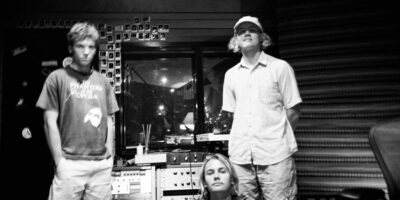There are very few bands around now who dare to dream and explore the unknown quite as much as Matmos. The Baltimore-based electronic duo is one of the few trailblazing acts still searching and experimenting, seeking a new sound in contemporary music. Since releasing their self-titled debut album in 1997, Matmos have cemented their reputation amongst the avant-garde, thanks largely to their use of highly unusual sound sources in their recordings.
“When things first started, we were just using things that were laying around our house,” says M.C. [Martin] Schmidt. “We try to always choose inspirational items, but the music on the first album came from the crap lying around, like the door to our room and a tie.
“Our reputation is to be outrageous, but we’re doing it for an aesthetic sense. These weird objects just fall into our laps now, and we think, ‘Oh yeah! We can use this!’ I mean, what other band have bovine insemination equipment lying around?”
Despite their nuanced approach to work, Matmos have been praised for the accessibility of their music. It seems quite contradictory that a band which creates music with amplified crayfish nerve tissue, liposuction surgical tools and bovine insemination equipment could apply pop sensibilities at the same time.
The truth is that the band is split about which direction in which to take the music – Schmidt driving into the experimental and the unknown, while Drew Daniel fights for the pop approach. “We’re in constant conflict about this. Drew loves pop music, but I couldn’t care less; I have a much slower metabolism for that kind of music. I’ve got nothing against it, but I would rather we head in a stranger direction, and Drew pushes in a more pop direction. It’s that conflict which drives what we do.”
The creative and experimental nature of Matmos has even seem them transcend the world of music, collaborating with visual artists, playwrights and choreographers, from Daria Martin to Young Jean Lee. “We’ve been lucky and have had such amazing people approach us and ask to help out with what they’re doing. They’ve always been very different from us, which allows us to be ourselves. It’s sometimes a stretch and a challenge to work with us, but they’ve been forgiving with our approach. They come to us and it’s been great fun.
“On the other side, when we ask people to work with us, it’s like we’re asking a neighbour to help with some home repairs. A lot of the people we’ve worked with are people we know, people I met at a bar.”
Schmidt reflects on a time working with an orchestra in Europe, when the conductor was shocked to discover that neither he nor Daniel can read sheet music. “We make it up as we go along. We were never trained in music composition and never learnt to read sheet music, so people have been surprised by us and our approach, but we somehow manage to find a way to make it all work and some amazing stuff has come out of these collaborations. It always comes together with relative ease and just feels natural.”
Ahead of their upcoming performances in Australia, including a date at Sydney Festival, the creative juices are flowing – and Matmos are dreaming up something special.
“The big difference between live and recorded music is that it’s much easier to be original and acceptable live,” says Schmidt. “We prefer that the audience doesn’t know the process of creation. With an album, they can study it and work out how we made our music, but performing live requires a more immediate digestion of the music. We like our audience to be smart enough to roll with the punches and not need an explanation for what we’re doing – immediate satisfaction rather than a subject of study.”
BY DANIEL PRIOR
Matmos play Sydney Festival 2014 at City Recital Hall, Angel Place on Wednesday January 15.Drew Daniel’s The Soft Pink Truth also appearing at Paradiso Lates, Sydney Town Hall on Thursday January 16.

































